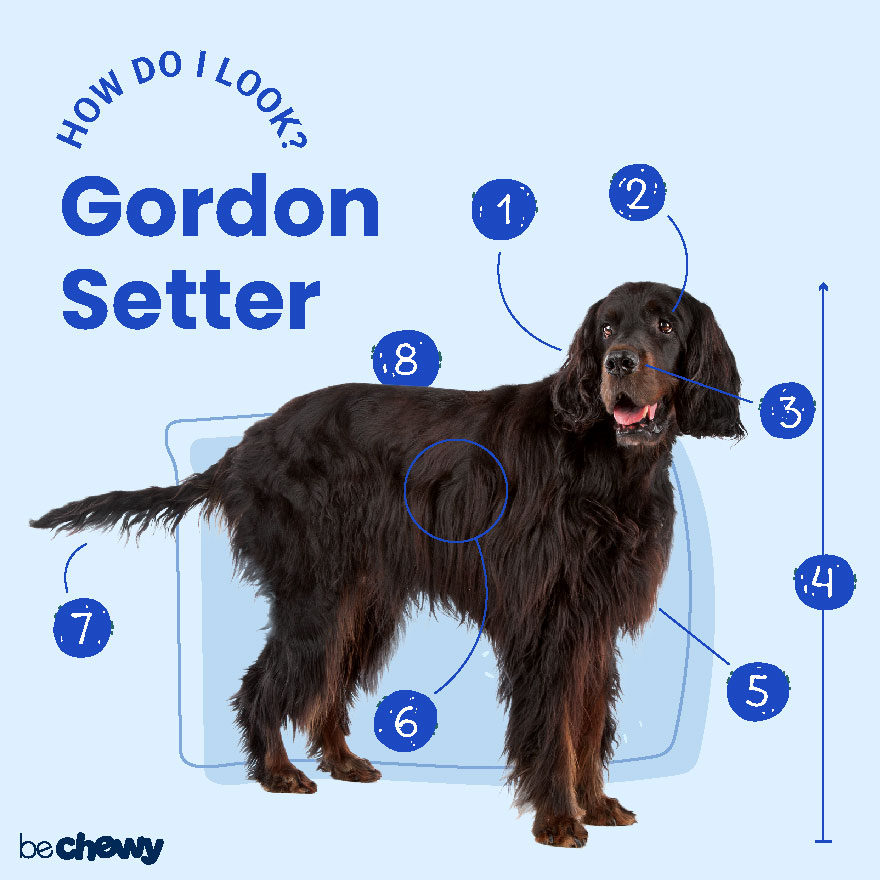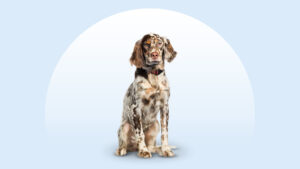Gordon Setter
Updated May 5, 2025
Gordon Setter
Updated May 5, 2025
Gordon Setters are loyal and intelligent dogs who love activity and outdoor adventure. They thrive in on-the-go homes with experienced pet parents who appreciate their affectionate nature and enjoy the great outdoors as much as they do.
Confident, Athletic, Affectionate
Male: 55 to 80 pounds
Female: 45 to 70 pounds
Male: 24 to 27 inches
Female: 23 to 26 inches
12 to 13 years
Black and Tan
A perfect blend of active and laid-back, Gordon Setters love a cuddle session and a scratch on their floppy ears after a day of hiking, perusing your local farmer’s market, or running around with your kids in the backyard—any time spent with you is good time, in a Gordon’s eyes. And if that time involves a specific task (fetching a ball, chasing a stick), all the better. These pups don’t require hours of grooming, but a regular brushing to keep the floof looking floofy is always a good idea. And though they can be a strong-willed at time, Gordons are ultimately hopelessly devoted to you and eager to please. What more could you want from a furry friend?
Gordon Setter Characteristics
Gordon Setter Appearance
The largest of the setter breeds, the Gordon Setter’s height can reach 27 inches tall at the shoulder, and their weight can be up to 80 pounds. Their colors are black with tan markings, and beneath their long, wavy coats, Gordon Setters are sturdy, muscular types bred for work. Their tails might be short, but that doesn’t stop Gordon Setters from wagging them a mile a minute when you ask, “Walk?”

- Ears
Gordon Setter ears are long, large and thin and covered in wavy black hair.
- Eyes
Gordon Setter eyes are dark brown and oval, giving them a bright, wise expression.
- Nose
Gordon Setters have broad, black noses with open nostrils.
- Coat Length
Gordon Setters have long, straight or slightly wavy coats. The hair on their ears, stomach, chest, legs and tail is longer than the rest of their bodies.
- Coat Color
The breed has a black coat with tan markings in shades ranging from chestnut to mahogany.
- Tail
The Gordon Setter tail is short, but not docked. It's wider at the root and narrows to a point at the tip.
Gordon Setter Temperament
Confident, alert and intelligent, Gordon Setters were bred to race off into the woods after birds. But no matter what their particular training is today, this breed truly flourishes when pet parents channel their dog’s energies into outdoor activities. The Gordon Setter temperament is not one for lazily sitting around and staring out the window at the action outside. They want to be right up in it.
That’s because a Gordon Setter dog loves two things most: Being on the move and spending time with their people. They are happiest when they can marry these twin passions by hiking, biking or hitting the dog park for some exercise alongside their humans, who they’ll then eagerly reward with loads of affection, love and loyalty. They are sweet-natured dogs, after all, and not overly hard to please.
Gordon Setters can be determined and strong willed, too, qualities that serve them well on a hunt as they push on until they find their marks. Nevertheless, this can make training a bit of a challenge. Still, with patience, the Gordon Setter can be a well-behaved member of the family.
Although Gordon Setters were bred to be working dogs, they’re not all business. These dogs definitely know how to play. And despite the Gordon Setter’s size, the breed is mild-mannered, good with kids of all ages and will quickly turn strangers into friends. Most Gordon Setters are happy to find other four-legged playmates, and the breed ranks low for both aggression and biting tendencies. If dogs held popularity contests, the Gordon Setter would be top contender for sure.
How to Care for a Gordon Setter
The key to caring for a Gordon Setter dog is exercise. This is a breed who loves activity and will do best in households where there are lots of opportunities for outdoor adventures. To ensure your Gordon Setter lives a happy, healthy life, take advantage of their intelligence with training activities that provide mental and physical stimulation, feed them a complete and balanced diet, groom them regularly and take them to the vet for routine care.
Grooming
Training
Diet
Exercise
Environment
Gordon Setter Health
The Gordon Setter’s life expectancy is 12 to 13 years. Although they are generally healthy dogs, the breed is at risk for certain health issues that can crop up during their lifetimes.
- Progressive Retinal Atrophy (PRA): This group of eye diseases is linked with degeneration of the retinal cells, eventually causing blindness. The inherited form of PRA, also called retinal dysplasia, is diagnosed in puppies; older dogs can be diagnosed with a late onset form of disease that typically appears between 3 and 9 years old. PRA isn’t painful, and the earliest symptoms, such as increased pupil dilation or bumping into objects, often go unnoticed. Although there is no treatment for PRA, there is a genetic screening test so be sure to ask your breeder. Pups can still lead happy lives, even if they lose sight.
- Hip and Elbow Dysplasia: Dysplasia is an often-genetic condition in which the joints don’t fit correctly and have laxity that can result in pain, lameness and arthritis. X-rays are used to diagnose hip and elbow dysplasia. Treatment typically includes weight management, joint supplements, pain medication and, in severe cases, surgery.
- Bloat: Like other large-breed dogs with deep chests and thin waists, the Gordon Setter breed is at increased risk for gastric dilatation-volvulus (GDV). The condition, better known as bloat, occurs when gas stretches the stomach and causes it to twist. It can be sudden and life-threatening. If you notice symptoms, such as your dog’s abdomen becoming enlarged, restlessness, non-productive retching/dry heaving and drooling, bring your dog to an emergency room immediately. Not allowing your Gordon Setter to exercise before or after eating can reduce the risk, as can feeding them smaller meals more frequently throughout the day and using a slow feeder. Some veterinarians also recommend a procedure called a gastropexy that involves stitching the stomach to the side of the body as a preventive measure against bloat.
- Hypothyroidism: Hypothyroidism is a common endocrine condition in which the thyroid gland does not produce enough thyroid hormone. Symptoms include weight gain, hair loss and lethargy. Diagnosis is typically a blood test and treatment most often is a daily oral medication.
- Cerebellar Abiotrophy: This inherited neurologic condition was first described in Gordon Setters in the 1980s. Also called hereditary ataxia, affected dogs develop stumbling in the rear limbs that progresses to trouble walking or eating and drinking. There is a genetic screening test so be sure to ask your breeder.
Gordon Setter History
The Gordon Setter’s history dates back to the 1500s when the earliest setter breeds were developed. This bird dog breed earned their name for their tendencies to quietly “set” down (or lie down) to alert hunters to the location of birds. The hunter would then toss a net over the birds and dogs, if necessary, to bring home game for supper.
A key figure in the Gordon Setter’s origin was the setter fancier Alexander Gordon, the Fourth Duke of Gordon in Scotland, who lived in the 18th and 19th centuries. He bred black-and-tan setters at his home, Gordon Castle. The dogs were heavier boned and more “square” than other setter breeds, providing them with strength and stamina, albeit not speed, and making them ideal for long hunts over tough terrain in their native Scotland. And hunt with his dogs, the Duke certainly did—although he waited until the setters were more than 5 years old because it took these “perpetual puppies” that long to settle down and mature.
Although the earliest iterations of the Gordon Setter looked more like English Setters, when breeders later crossed them with flat-coated black-and-tan Collies, Bloodhounds, black Pointers and black Setters, they got the Gordon Setter breed as it’s known today.
Historic records show that George Blunt brought the first Gordon Setters to New York in 1842—a curly-coated white Setter with black and tan points named Rake and a black-and-tan Setter named Rachael. Although the American Kennel Club welcomed the black-and-tan Setter as an official breed in 1884, they changed the breed name from the Gordon Castle Setter to the Gordon Setter in 1892.
If you’re thinking about adding a Gordon Setter to your family, you can find a list of reputable breeders on the American Kennel Club’s website. The average price for a puppy ranges from $1,000 to $2,000. But for that cost, you usually get a dog who’s been screened for health and temperament issues, and they might even come with pedigree papers. You can also reach out to Gordon Setter rescue organizations to adopt a dog, keep an eye out for the breed at your local animal shelter, or search Chewy’s database of adoptable dogs in your area.
FAQs
Do Gordon Setters shed?
How long do Gordon Setters live?
Are Gordon Setters good family dogs?
Do Gordon Setters bark a lot?
What are the most common Gordon Setters dog mixes?
Expert input provided by veterinarian Dr. Jami-Lyn Derse DVM, founder of Veterinary Housecall Care LLC and certified dog trainer Marissa Sunny CPDT-KA, canine behavior specialist at Best Friends Animal Society.
Breed characteristic ratings provided by veterinarian Dr. Sarah J. Wooten, DVM, CVJ, a veterinarian at Sheep Draw Veterinary Hospital in Greeley, Colorado; dog trainer and behavior consultant Irith Bloom, CPDT-KSA, CBCC-KA, CDBC, owner of The Sophisticated Dog, LLC, in Los Angeles; and certified animal behavior consultant Amy Shojai, CABC, in Sherman, Texas.
The health content was medically reviewed by Chewy vets.








